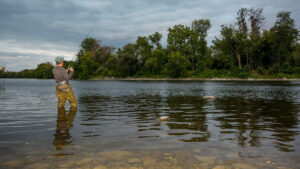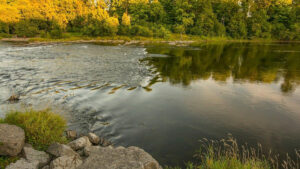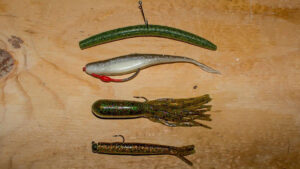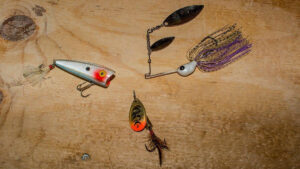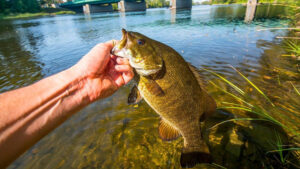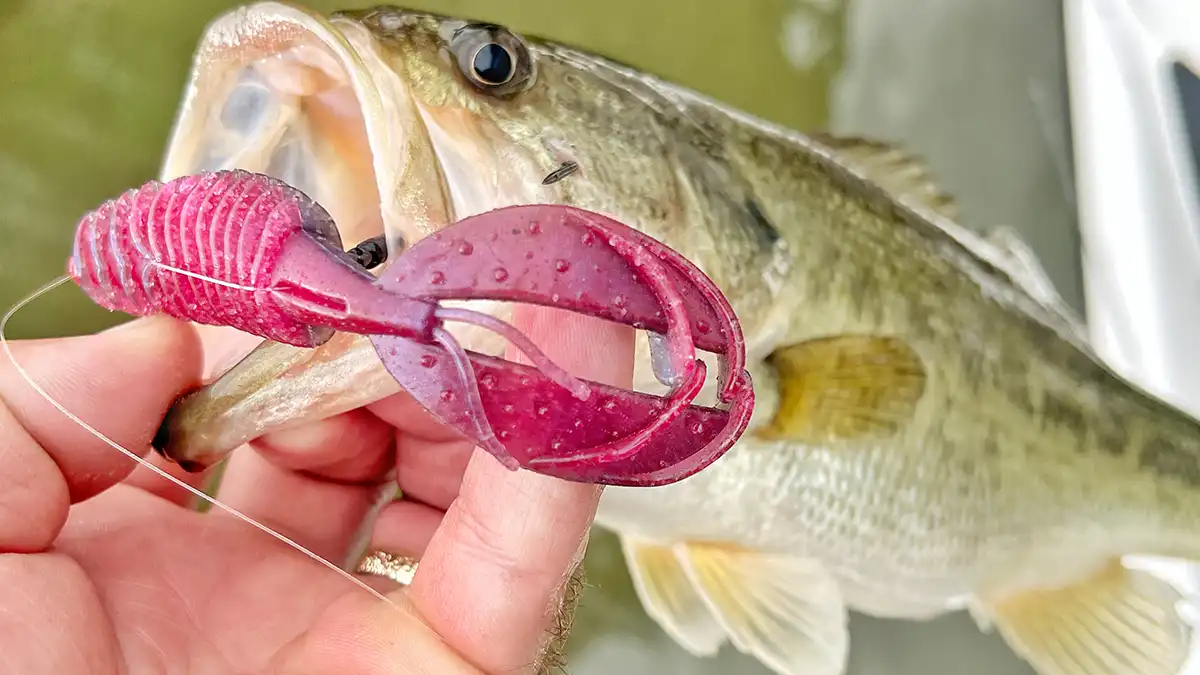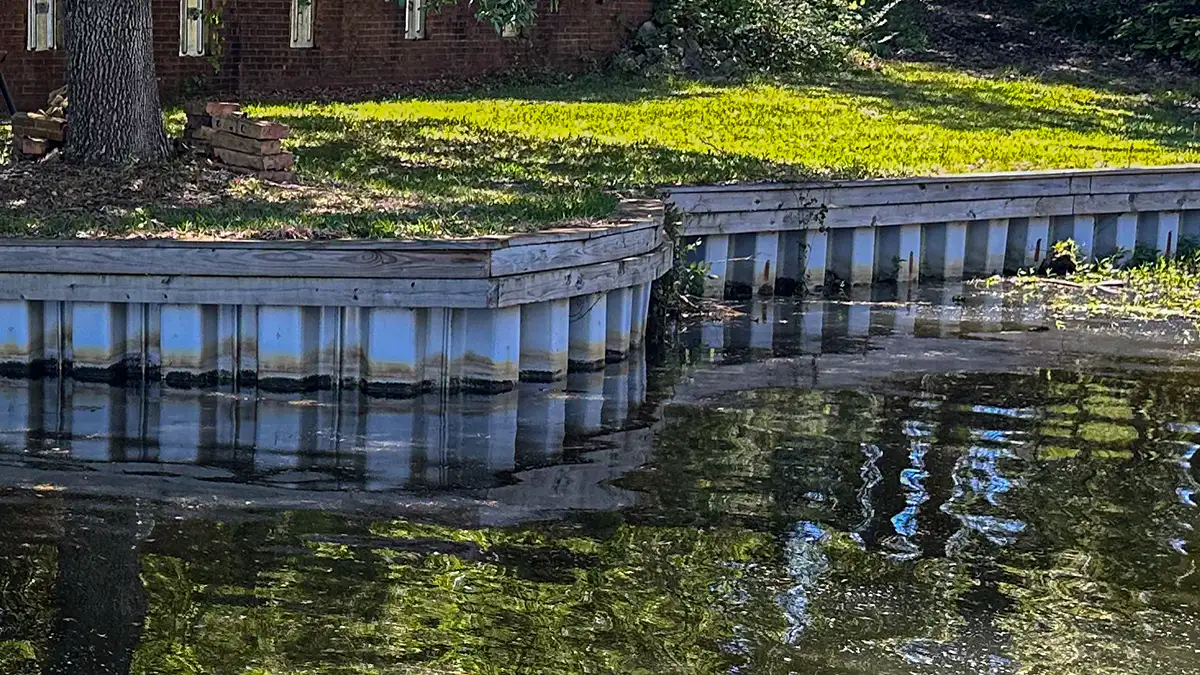Bank fishing a river is a great way to catch a lot of smallmouth bass and have heaps of fun. Current breaks, rapids, boulders, river bends, grass lines and timber are all smallmouth hangouts on rivers. Reading water to locate these spot’s isn’t enough. A bank angler must know how to present jigs, soft baits, topwaters and other smallmouth lures naturally in current to fool stream-dwelling bass.
I cut my angling teeth shore fishing smallies and still regularly wet a line from the bank. If you’re new to fishing rivers for bronzebacks, these tips will help you catch more fish from small to medium systems.
- 8 reliable river spots
- What river smallmouth eat
- Stream smallies tackle tips
- Hard lures work too
- Bank fishing gear suggestions
8 reliable river spots
One of the best things to do after getting to the bank is observing the river for a few minutes to find the areas likely to hold smallmouth. Here are 8 spots to look for when chasing river bronzebacks.
1. Rapids
Smallmouth like the fast water below rapids. Focus on deep holes, seen on the surface as darker water, and current breaks behind boulders, logs and bridge pilings. Bass are fond of these deeper, shaded pockets.
2. Current seams
A current seam is a ripple line on the water’s surface. It forms from the turbulence when fast and slow sections of water converge.
Smallmouth hold in the slow water to conserve energy. They stay close to fast current to pounce on forage swept downstream in the swift flow.
Current seams are created by boulders, reefs, logs, points, wing dams, bridge pilings and other obstructions. Outflows from a dam, culvert or tributary can also create seams.
3. Pools
A pool describes a section of deep water within a river. Pools can contain sunken timber, rocks and other attractive features for bass. When it’s hot or when smallmouth are sulking, anglers drift jigs through pools for success.
4. Bends
Current and structure change where a river bends. These areas often hold smallmouth. Sand bars form on the inside of the bend where the current slows. The outside bend has faster current. It’s eroding force makes deep holes as well as shoreline undercuts.
5. Points and wing dams
The current breaks and rocks of points and wing dams are smallmouth magnets. One of these structure’s on an otherwise Plain Jane stretch of river’s a gem sure to hold quality bass.
Wing dams are common downstream of a dam. These are excellent bank fishing spots.
6. Grassy banks
Smallmouth hold in shaded or deep water along grassy shorelines. Here, bass lurk
waiting for grasshoppers and other terrestrial snacks to fall into the water. Smallmouth will hide among rocks and timber near the bank for added cover.
7. Grass lines
Current pushes vegetation. Smallmouth tuck in behind swaying stalks and bent over plants for cover and shade. The growth creates a slight current break. Pockets and edges are casting targets.
Don’t discount sparse grass patches. These can hold smallmouth on sand bars.
8. Log jams and other timber
Smallmouth like wood in rivers. Lay-downs, log jams, stumps, old docks and other lumber scenarios provide cover, shade and a current break. Wood also holds invertebrates and attracts baitfish.
What river smallmouth eat
You can get tips on what bass in a river might be eating by keeping your eyes open.
Look on the shoreline for crayfish shells, for instance. The casings are likely the leftovers from a raccoon or other resourceful critter, but seeing the shells is a clue a bait decoying a crayfish is a good pick for smallies. Flip some rocks to find a live one. Keep its coloration in mind when picking a bait.
Minnows are common river forage, too. Always watch for smallmouth busting baitfish on a river. Recently, while walking the bank I saw a school of baitfish holding in a culvert. It’s amazing how often minnows relate to these structures.
River smallmouth also eat nymphs and bugs. Given this, look for insect activity on the surface. Watch for swooping birds munching on bugs.
Insect hatches stimulate the food chain. Bass may eat the insects, or hunt baitfish preying on the bugs, or both. Getting a lure around insect hatches puts it near active smallies.
River smallmouth tackle tips
Smallmouth are suckers for soft baits. In rivers a jig and plastic, a wacky rigged stickbait and a Tex-posed soft jerkbait are excellent presentations.
All of these baits are great for making precision casts to specific targets, such as pockets and the outside edge of a grass bed. The baits are also excellent for covering rocky areas when cast parallel to the bank and kept above snags.
Another excellent bank tactic is drifting a jig, stickbait or jerkbait. The method covers water. It’s well suited for probing pools or current seams. It’s also great for sneaking a bait under overhanging trees or close to other cover. Here are 7 tips on drifting soft baits:
Go light – Use a light 1/16- to 1/4-ounce jig so it drifts naturally downstream, matching current speed.
Think 45 – Cast the bait at a 45-degree angle upstream, and let it drift to a 45-degree angle downstream.
Mend it – To help the bait drift naturally, mend the line by allowing the slack on a cast to land upstream and then take it up as the bait drifts so the current doesn’t pull the bait with a bow in your line faster than natural.
Use the rod – Follow the drifting bait with the rod tip and retrieve line to maintain contact.
Hop and twitch – Use a pop of the rod twitch to give the bait a natural added action and keep it free of snags.
Start short – Start close to the bank and cast farther each time to cover water.
Avoid debris – If there are floating leaves or grass, avoid drifting baits as you’ll just fight debris unnecessarily.
Other tackle considerations for river smallmouth
While soft baits are good for river smallmouth, topwaters and spinnerbaits also produce on rivers.
Topwaters
Smallmouth chasing forage readily eat surface plugs, and topwaters excel in low-light conditions.
Poppers and wakebaits work well in rivers for smallmouth. Anglers can float the bait over snags and vegetation and let the bait slide into the strike zone or call fish out of deeper water.
Spinnerbaits
Rivers can be complex and sometimes intimidating to fish. An inline spinner produces and makes covering water easy.
An inline spinner casts like a bullet, tracks excellent in current, and emits vibration and flash with excellent hookup rates.
Use French bladed spinners for added lift in shallow water. For deeper retrieves, or swifter current, a willow-leaf blade works more efficiently.
A wire-arm spinnerbait will be more efficient in weedy, snaggy areas.
Gear tips
A 6-foot, 6-inch to 7-foot medium or medium-light spinning rod teamed with a 1500-sized reel and 6- to 8-pound monofilament will handle most situations. Switching to thin-diameter 10- to 15-pound braid can help get jigs to the bottom faster and increase casting distance.
If you’re up for carrying two rods, bring a 7-foot, medium baitcaster with 10- to 15-pound mono for tossing spinnerbaits and topwaters.
Use a lure wrap to cover a bait and prevent mishaps when walking a bank.
Waders or rubber boots help cover more water and increase casting opportunities.
Carry tools and tackle trays in a fanny tackle pack or backpack.
Wear polarized glasses to cut glare on the water, so you can see more of what is beneath the surface.
Read a river to find the best spots and remember to present baits naturally in current. Do these things right, and you’ll land heaps of hard-fighting bronzebacks from the flow.



